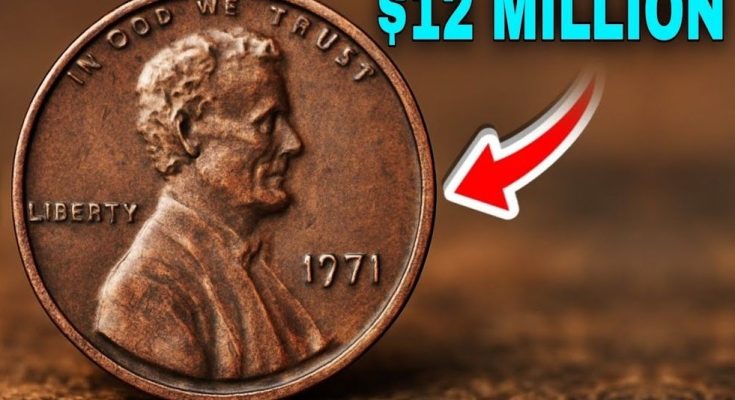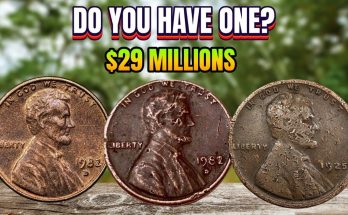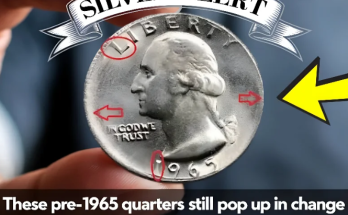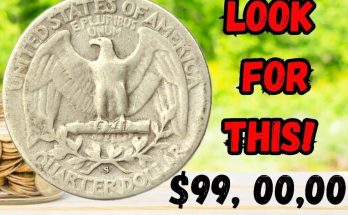Have you ever wondered if that old penny sitting in your change jar could be worth a fortune? Believe it or not, some rare coins hiding in everyday pockets have turned ordinary people into millionaires. The coin pictured here—a 1971 Lincoln penny—may look like any other cent you’ve seen, but under certain rare conditions, a penny like this could be worth thousands, even millions, of dollars to collectors. Let’s explore why some old pennies are so valuable, what makes them special, and how you can check your coins to see if you’re sitting on hidden treasure.
First, let’s start with a bit of history. The Lincoln cent, featuring the portrait of Abraham Lincoln, was first introduced in 1909 to mark the 100th anniversary of Lincoln’s birth. Over the years, billions of these coins have been minted, making them one of the most common coins in U.S. history. But among these billions, a few rare mistakes—called “mint errors”—or unusual variations can make a coin incredibly valuable. These rare versions are what collectors spend years searching for.
The 1971 penny in the photo looks ordinary at first glance. It shows Lincoln’s profile, the word “LIBERTY,” and the date “1971” on the front. However, some pennies from this year were struck with special characteristics that make them worth a fortune. For example, there are 1971 “double die” pennies where the design was accidentally stamped twice, causing a noticeable doubling of letters and numbers on the coin. These errors are not just interesting—they’re extremely rare and collectible.
A true “1971 doubled die obverse” penny can sell for hundreds or even thousands of dollars, depending on its condition. But the stories of ultra-rare coins worth millions often come from unique minting accidents, limited releases, or coins made from the wrong metal. Imagine a penny accidentally struck on a silver planchet (a blank piece of metal used to make coins) instead of the usual copper one—such mistakes are priceless to collectors.
Now, you might wonder: is a penny really worth $12 million, as seen in the image? The truth is, while most 1971 pennies are worth only one cent, certain ultra-rare error coins have sold for staggering amounts. The claim of a $12 million penny is based on the fame of other extremely rare coins, such as the 1943 copper penny and the 1794 Flowing Hair dollar, both of which have reached multi-million-dollar auction prices. If a 1971 penny were to have a one-of-a-kind minting error, or if it was part of a unique prototype batch, its value could skyrocket.
So, how can you tell if your penny is special? Start by examining it closely under a magnifying glass. Look for doubling on the letters “LIBERTY,” “IN GOD WE TRUST,” or the date “1971.” If you notice a clear double outline, you may have a doubled die penny. Also, check for unusual coloration, weight differences, or any signs that the penny was made from a different metal. Some rare 1971 pennies were minted in both copper and bronze alloys, and even small variations can influence the coin’s worth.
Condition also plays a huge role in determining value. Collectors use a grading system to evaluate a coin’s condition, ranging from “Good” (worn and circulated) to “Mint State” (untouched and shiny). A flawless coin with strong details, no scratches, and no wear can be worth significantly more than the same coin that has circulated for decades. Professional grading services like PCGS (Professional Coin Grading Service) or NGC (Numismatic Guaranty Corporation) can authenticate and grade coins, giving collectors and sellers confidence in their value.
The world of coin collecting, or numismatics, is fascinating because it turns small pieces of metal into pieces of history. Every coin tells a story—about the era it was made, the technology of the mint, and even the mistakes that happened along the way. That’s why collectors are willing to pay big money for rare examples. What’s ordinary to one person could be a once-in-a-lifetime discovery to another.
If you’re curious about your own coins, take a moment to go through your change jar, old coin collections, or inherited sets. Look for older pennies—especially those made before 1982, when the U.S. Mint switched from copper to mostly zinc. Coins from the 1940s, 1950s, and 1970s often hide valuable varieties that most people overlook. The key is research, patience, and knowing what to look for.
To sum it up, while not every 1971 penny is worth $12 million, some rare coins from that year and others have fetched incredible prices due to their unique minting errors or composition. The potential for finding one is what makes coin collecting so exciting. You never know when a simple coin in your pocket might change your life. So, check your change, dust off your old coin albums, and take a closer look—you might just discover that one cent could truly be worth a million dollars.



